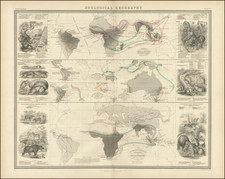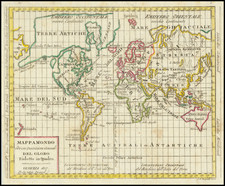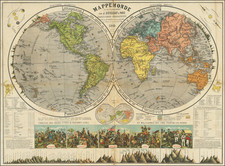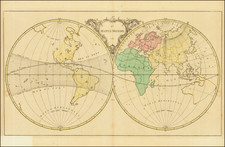Manuscript panels of Matteo Ricci's famous world map, the first Chinese map done in a Western style
Matteo Ricci's world map is one of the most fascinating, and rare, world maps in existence. Its importance lies in its content-the first Chinese map done in a Western style and the first to portray European exploration up to the sixteenth century-as well as in its symbolic value as an exchange of cultures and intellectual practices. In 2016, Barry Lawrence Ruderman Antique Maps Inc. acquired two hand drawn panels from an early seventeenth-century example of Matteo Ricci's map of the world. These panels are only the sixth known extant manuscript copy of Ricci's famous map and only the second known example to have been in the western hemisphere.
Matteo Ricci and his world map
Ricci, a Jesuit missionary, was born in Macerata, Italy and educated in the Jesuit school there. He later trained at the Roman College in several subjects including globe and mapmaking; while there he also requested to join the Jesuit order. In 1577 he was sent to Portugal to continue his studies and, a year later, set off for Goa as a missionary. After being ordained at Cochin, on the Malabar Coast, he arrived in China in 1583.
Ricci brought with him several atlases and maps, the most prominent being Ortelius' Theatrum Orbis Terrarum (1570). Ricci is supposed to have hung a world map on his wall in Zhaoqing, most likely Ortelius' Typus Orbis Terrarum from the aforementioned atlas. The map caused quite a stir among his Chinese visitors, differing as it did from received Chinese geographic knowledge about the world's geography. When asked to make a copy of the map in Chinese, Ricci complied. The map was engraved and printed, but no copies survive.
Ricci made another edition of his world map in 1599, but this too has not survived. The 1602 third edition, however, does still exist. Ricci received assistance from Li Zhizao, Chinese mathematician, astronomer, and geographer, in creating the work, entitled Kunyu wanguo quantu, or Map of the Ten Thousand Countries of the Earth. The xylograph (wood block print) is printed on six panels. Unlike most European world maps, this map centers on the Pacific Ocean. It shows five continents (Libya (Africa), Europe, Asia, America, and Magellanica, a southern continent) and four oceans (Atlantic, Indian, Pacific, and Arctic). Flanking the oval projection is a geographic treatise, a table showing the distance between the planets and earth, and two insets of the northern and southern hemispheres. In addition, text blocks pepper the map itself. For example, of the Nile he writes, "the longest river in the world. It flows into the sea through seven mouths. In this country there are no clouds or rain all the year round, hence the inhabitants are skilled in astronomy." Of Canada, "The inhabitants are kindly and hospitable to strangers. In general, they make their clothes out of skins, and are fishermen by occupation."
The printer, Zhang Wentao, made a copy of the blocks and people reportedly brought their own paper to make copies. This pirated version was identical to the official one. Ricci said there were thousands of copies of the 1602 map circulating, but only six complete copies are known today. They are in the Vatican Apostolic Library, the Kyoto Imperial University, the Miyagi Prefecture Library, the Japanese National Archives (Tokyo), a private collection in Paris, and the James Ford Bell Library at the University of Minnesota. None of these copies have figures and only the Miyagi and the Paris copy are in color.
Subsequent examples of the Ricci world map
In 1603, Ricci made a larger, eight panel version of the 1602 map. Three copies survive of this edition, at Soongsil University Christian Museum, Liao Liang Province (color), and another in an unreported location in Seoul. In 1604 the Viceroy of Kweichow, Kuo Ch'ing-luo, issued a booklet based on the 1599 map. In 1608 the Wanli Emperor requested twelve copies of the 1602 map. However, by this time the original blocks were not in Beijing, but in Hangchow, and the second set of blocks had been ruined in a flood. Ricci remade his map, in eight panels, but no copies of this map are known in any collections today. Ricci died in China in 1610.
Multiple copies of the map were made in Japan, Korea, and China throughout the seventeenth and eighteenth centuries. All printed copies were made in China, while manuscript copies (with and without figures) were made in Japan and Korea that vary in their adherence to the original print. Of the printed copies, three were printed after 1644, when the Ming Dynasty gave way to the Qing. They are held in the Royal Geographical Society (RGS), the Austrian National Library, and the Vatican Library (3 panels, one of which is panel 4). Like the 1602 copies, none of these have figures.
A further category of the maps are manuscript copies made in the mid-seventeenth century or later. These have been studied extensively by John Day, who thinks they are derived from Chinese printed copies that were copied in China and Korea. There are six recorded examples: the Beijing National Library fragment (see next paragraph), the Kendall Whaling Museum fragment (see next paragraph), a ten panel version in the Kitamura Collection dated 1708, a six panel version in the Nanjing Museum which d'Elia dates to 1672-4, the so-called Nicolas six panel version dated 1732, now most likely destroyed, and an eight panel version in the Seoul National University. As the Nicolas map is most likely gone, this is the sixth extant manuscript copy.
Additionally, several fragments of the 1602 survive. The New Bedford Whaling Museum has a manuscript panel 3 (with figures, formerly in the collection of the Kendall Whaling Museum). In the 1980s a researcher found a manuscript panel 4 in the Beijing National Library (with figures). Finally, there are printed panels 1 and 6 held by the University of Bologna (no figures). As with the surviving 1602 copies, the text on both panels offer geographical and oceanographical information. At the top of panel 6 there is an explanation of eclipses and a method for measuring the Earth and Moon. On panel 1 there is an armillary sphere in the lower corner and a model of the solar system in the upper corner. On panel 6 there are two hemispheric insets, with the northern hemisphere in the upper corner and the southern in the lower.
The Ruderman example
The panels purchased by Barry Lawrence Ruderman Antique Maps Inc. in 2016 are a mix of the features of the existing copies. Like Bologna, they are panels 1 and 6. However, both panels have been cropped in the lower portion of the panels. The armillary sphere is entirely missing from panel 1, while the lower half of the southern hemisphere is lacking from panel 6. In addition, the panels have the same complement of figures as the other manuscript copies with figures.
Christie's described the panels as follows:
Panel one (extreme right-hand panel): title to extreme top right-hand corner, the figure of the Nove Cieli (Nine Skies) to the left of title, illustrated as per 16th-century conceptions, with accompanying explanatory text detailing the movement of the planets, with further text panels describing general geographical and oceanographic knowledge; the cartography showing portions of Greenland, Labrador, Newfoundland, Nova Scotia, the Azores, South America, including the rivers Amazon and Plate, and part of an Antarctic continent, 1345 x 625mm, pen and ink and watercolour manuscript map on paper, lines of longitude in pen, the Arctic Circle, Tropic of Cancer and Tropic of Capricorn delineated in straight lines in red, the Equator in a straight line with red and yellow colouring consistent with the hemisphere edge, three large sea monsters, one of which appears to be a hammerhead shark, mountain chains within continents, toponyms in Chinese (trimmed short at bottom by approx. 335mm, lacking astronomical diagram and approx. 20 lines of Chinese text).
Panel six (extreme left-hand panel): two small diagrams at top demonstrating eclipses with textual explanation, as well as the method for measuring the Earth and the Moon and a proof that the sun is larger than the moon; the cartography showing portions of Greenland, Iceland, western Europe, including Ireland, the Low Countries, France, Spain and Portugal, northern and western Africa, with the River Gambia depicted, extending down the west coast of the continent to South Africa, with a part of an Antarctic continent, 1440 x 618mm, two polar projections in top left-hand and bottom right-hand corners, pen and ink and watercolour manuscript map on paper, lines of longitude in pen, the Arctic Circle, Tropic of Cancer and Tropic of Capricorn delineated in straight lines in red and extending beyond the hemisphere edge, the Equator in a straight line with red and yellow colouring consistent with the hemisphere edge, North and South Atlantic Oceans with 2 large sea monsters, one of which appears to be a whale blowing, and 3 ships, one of which is an oared galley, mountain chains within continents, toponyms in Chinese (trimmed just a fraction into top line of text and diagrams, and cut short at bottom by approx. 240mm, into Antarctic polar projection and Antarctic continent).
In light of the other extant copies, there are several issues to take into account when attempting to identify and date the Ruderman panels. First, is it a manuscript or a print? The name of the printer, Zhang Wentao, is included on the Ruderman panels, yet a good copyist would have included this as well as the year 1602, even if it was copied later. Curiously, one expert, pointed out that the date on the map is copied somewhat erroneously. The original map indicates the *renyin* year of Wanli: 萬曆壬寅 (1602); this copyist mistakenly used the very similar character *wang*王 for 壬. After polling several experts, the consensus came to the panels being manuscript copies, which is in line with a copyist error as to the date. This consensus is further supported by the fact that none of the surviving copies with figures are prints; they are all manuscripts.
Several experts consulted during the research process mentioned that our panels might be part of one of the 1608 editions made for the Wanli Emperor. However, no confirmed copy of the 1608 editions exists, thus a definitive identification as 1608 is impossible and, based on other evidence, highly improbable.
The three copies, sans figures, held by the RGS, the Austrian National Library, and the Vatican Library can be dated as post-1644 because that is the year the Ming Dynasty's capital of Beijing fell to Li Zicheng of the Shun dynasty. The Shun was soon replaced with the Qing, and it is the Qing that is mentioned on these three copies of the 1602 map. Similarly, the Qing is mentioned on the Ruderman panels, specifically panel 6 in the northern hemisphere inset in the upper left corner. Interestingly, four characters say "the Great Qing" on mainland China, but three characters in the sea say "The sea of Great Ming." One expert surmised that the map was originally made in the Ming Dynasty but was altered in the Qing. However, it is more likely that the map was copied in the Qing and the copyist forgot to replace the mention of the Ming.
Both errors (in the date and the dynasties) point to a non-Chinese copyist. As previously stated, there are numerous Japanese and Korean copies made in the seventeenth and eighteenth centuries. As Day explains, the Japanese copies do not tend to have figures. Similarly, the presence of the Jesuit seals seemingly suggests that they were not made in Japan, which ejected their Jesuit missionaries in 1614. In addition, the Edo shogunate banned the importation of missionary books by 1630. However, there were copies of the 1602 map in Japan as early as 1604 and further copies were made throughout the Edo period. Finally, Japanese copies tend to replace the five characters used for "Portugal" in the 1602 original with a three character Japanese transliteration. This is the case with the Ruderman panel 6.
The Ruderman panels have the figures which are also included in the manuscript copies dated post-1644. The Seoul, Nanjing, Kendall Whaling Museum, Nicolas, Kitamura, and Beijing all have the "same basic complement of figures" and suggests that they are all copied from the same source(s). Day surmises that none of the extant manuscript copies are the original, which was likely made before 1623, although the Seoul map is the closest to the 1602 original. He concludes that there were most likely two interim maps from which the manuscripts were copied. It is quite possible that these panels are from one of those interim maps and therefore a crucial ink in the story of the one of the world's most important maps.
Provenance: Kaminski Auctions, November 2016.









![Pour Les Vents [world map centered on Asia]](https://storage.googleapis.com/raremaps/img/small/59768.jpg)


![[ World Atlas ] Geography Anatomized: or, A Compleat Geographical Grammer. Being a Short and Exact Analysis of the whole Body of Modern Geography... To which is subjoin'd the present State of the European Plantations in the East and West Indies, with a Reasonable Proposal for the Propagation of the Blessed Gospel in all Pagan Countries.](https://storage.googleapis.com/raremaps/img/small/85550.jpg)

